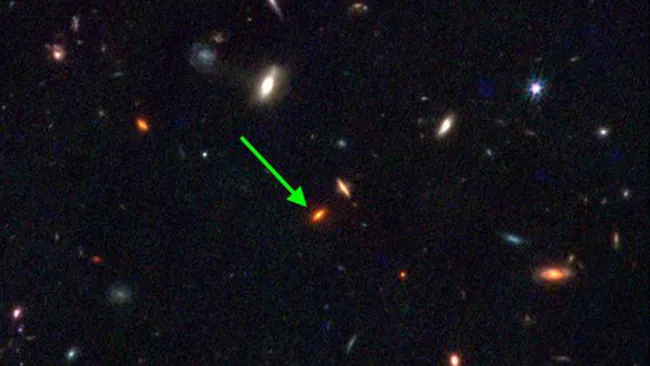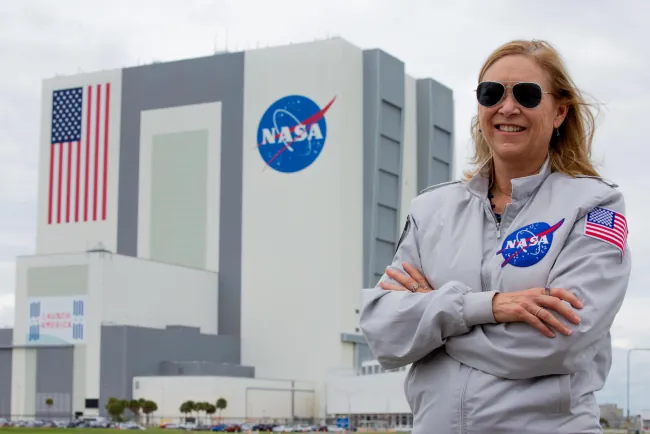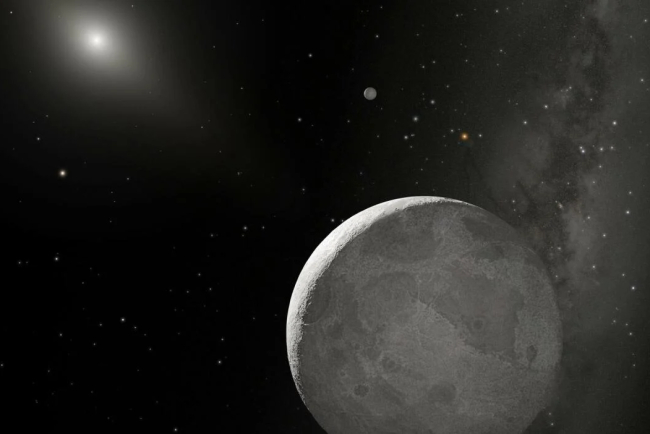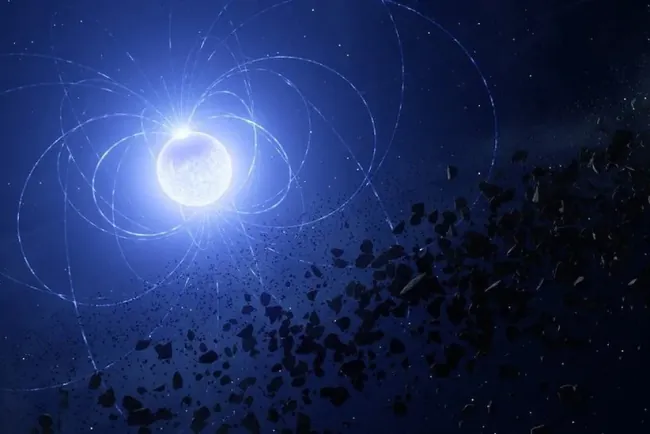Galaxy Found by James Webb Challenges Cosmological Theories
The James Webb Space Telescope's discovery of an ancient galaxy larger than the Milky Way

-
Introduction
- The groundbreaking discovery by James Webb Space Telescope (JWST)
- The challenge to existing cosmological models
-
Understanding the Universe's Timeline
- The standard model of galaxy formation
- The role of dark matter in cosmology
-
James Webb Space Telescope: A New Window into the Cosmos
- Overview of JWST capabilities
- JWST's contribution to astronomy
-
The Enigmatic Galaxy ZF-UDS-7329
- Discovery and basic characteristics
- Comparison with the Milky Way
-
Challenging Conventional Cosmology
- Implications for the standard model
- The mystery of its massive size early in the universe
-
The Formation of Galaxies Without Dark Matter
- Theories and speculations
- Insights from the discovery
-
Exploring the Early Universe
- How JWST allows us to look back in time
- The significance of observing ancient galaxies
-
The Spectra of Light: Deciphering Cosmic Histories
- Techniques in studying distant galaxies
- Findings from ZF-UDS-7329's light spectra
-
Redefining Cosmic Timelines
- Reevaluation of galaxy formation theories
- The role of dark matter in early galaxies
-
The Future of Cosmological Research
- Next steps in studying ancient galaxies
- Potential for further discoveries with JWST
-
Impact on Astrophysics and Cosmology
- Broader implications for the field
- Reactions from the scientific community
-
Public Interest and Educational Outreach
- Enhancing public understanding of cosmology
- Resources for further exploration
-
Technological Marvels: The Engineering Behind JWST
- Design and operation of the telescope
- Challenges and achievements
-
Cosmological Mysteries and Theories
- Overview of current cosmological puzzles
- The importance of challenging existing theories
-
Galaxy ZF-UDS-7329 in the Context of the Universe's Evolution
- Its place and significance in cosmic history
- Comparisons with other ancient galaxies
-
The Role of International Collaboration in Cosmic Discoveries
- The global effort behind JWST
- Contributions from various countries and organizations
-
FAQs
- Common questions about the discovery and its implications
-
Conclusion
- Summarizing the significance of the findings
- The future of space exploration and cosmology
James Webb Space Telescope Unveils Ancient Galaxy, Shaking Up Cosmological Theories
Explore how the James Webb Space Telescope's discovery of an ancient galaxy larger than the Milky Way challenges existing cosmological theories and redefines our understanding of the universe's formation.
Introduction
The James Webb Space Telescope (JWST) has made a groundbreaking discovery that challenges the bedrock of cosmological theory. Astronomers have identified an ancient galaxy, ZF-UDS-7329, that existed roughly 13 billion years ago, well before the expected time frame for such massive galactic formations according to the standard model of cosmology. This revelation not only questions our understanding of galaxy formation but also the fundamental role of dark matter in the cosmos.
Understanding the Universe's Timeline
Traditionally, cosmologists believed that galaxies formed around giant halos of dark matter. This invisible substance, making up about 25% of our universe, was thought to be essential for the birth of galaxies. However, ZF-UDS-7329's existence, teeming with more stars than our own Milky Way and forming just 800 million years after the Big Bang, defies these long-held assumptions.
James Webb Space Telescope: A New Window into the Cosmos
The JWST, with its unparalleled observational capabilities, has opened new frontiers in the quest to understand the universe's earliest days. By peering back over 11.5 billion years, the telescope offers a unique glimpse into the cosmos's infancy, bringing to light phenomena that were previously beyond our reach.
The Enigmatic Galaxy ZF-UDS-7329
ZF-UDS-7329 stands as a colossal puzzle. Its vast size and early formation present a "significant challenge" to the standard model of cosmology. This ancient galaxy's existence suggests that galaxies can form under different conditions than previously imagined, possibly without the direct influence of dark matter.
Challenging Conventional Cosmology
The discovery of ZF-UDS-7329 forces a reevaluation of the cosmic timeline and the processes that lead to galaxy formation. This finding adds to a growing body of evidence from the JWST that ancient galaxies were not only present but also more developed than current theories predict, early in the universe's history.
The Formation of Galaxies Without Dark Matter
How ZF-UDS-7329 and similar galaxies formed remains a mystery. The absence of dark matter in their early development stages suggests alternative mechanisms at play, challenging the prevailing theories of galaxy formation and evolution.
Exploring the Early Universe
The JWST's ability to observe the light from distant galaxies allows astronomers to travel back in time, uncovering the conditions that prevailed in the early universe. These observations are crucial for understanding how the first matter coalesced into the structures we see today.
The Spectra of Light: Deciphering Cosmic Histories
By analyzing the light spectra emitted by the stars within ZF-UDS-7329, researchers have deduced that these stars were born approximately 13 billion years ago. This technique provides invaluable insights into the galaxy's composition and history, offering clues to its formation and evolution.
Redefining Cosmic Timelines
The discovery of ZF-UDS-7329 and its implications prompt cosmologists to rethink the timeline of the universe's evolution. The existence of such massive galaxies early on suggests that the process of galaxy formation began much earlier and under different conditions than previously believed.
The Future of Cosmological Research
With ZF-UDS-7329 challenging our understanding of the cosmos, the stage is set for a new era of astronomical research. The JWST will continue to play a pivotal role in exploring the universe's earliest galaxies, potentially uncovering more anomalies that could further reshape our cosmological models.
Impact on Astrophysics and Cosmology
This discovery has profound implications for the field of cosmology, offering a fresh perspective on the universe's structure and formation. It underscores the importance of revisiting and revising our theories in light of new evidence, a fundamental principle of scientific inquiry.
Public Interest and Educational Outreach
The JWST's findings have captivated the public imagination, highlighting the importance of space exploration and scientific research. By extending the frontiers of our knowledge, such discoveries inspire future generations to pursue studies in science, technology, engineering, and mathematics (STEM).
Technological Marvels: The Engineering Behind JWST
The JWST represents a feat of engineering and scientific collaboration. Its design and capabilities allow it to capture light from the most distant corners of the universe, providing unprecedented views of the cosmos.
Summary:
The James Webb Space Telescope (JWST) has unveiled an ancient galaxy, ZF-UDS-7329, that is challenging the core principles of cosmology. Existing roughly 13 billion years ago and boasting more stars than the Milky Way, this galaxy's formation period contradicts the standard cosmological model, which posits galaxies formed around dark matter halos. This finding not only questions our understanding of galaxy formation but also suggests alternative mechanisms could be at play, independent of dark matter's influence.
The JWST's advanced capabilities have opened a new window into the universe's infancy, allowing astronomers to observe phenomena previously beyond our comprehension. ZF-UDS-7329's discovery prompts a reevaluation of the cosmic timeline and the processes leading to galaxy formation, suggesting that the universe's evolutionary process began much earlier than believed.
This revelation is part of a growing body of evidence indicating the presence of advanced galaxies early in the universe's history, thereby challenging conventional cosmology. The implications for astrophysics and cosmology are profound, necessitating a revision of our theories on the universe's structure and formation. The JWST's ongoing exploration of the cosmos is set to continue reshaping our cosmological models, highlighting the dynamic nature of scientific discovery and the endless mysteries of the universe.
What's Your Reaction?






















